The Lindisfarne Gospels exhibition at the Laing Art Gallery
17 August 2022
A 21st century perspective
"When Tyne & Wear Archives & Museums bid to host the Lindisfarne Gospels in 2022, we decided that we would like to explore the Gospels from the perspective of 21st century society in the context of an ever changing and challenging world. We have woven questions through our learning and engagement programmes about what it means to be human today and talked to people about things that are sacred or treasured in their everyday lives. We are taking a more philosophical approach than previous exhibitions in the North East about the Gospels, which have largely been about its history.
"We have also involved artists in the curation and conceptual aspects of the exhibition and the engagement programme, namely Ruth Ewan and Turner Prize winning artist Jeremy Deller, both of whom work with real people in the development of their art work and whose practice is socially engaged. We hope that people from across the North East and visitors to the region will enjoy the exhibition, not just to see this iconic and beautiful artefact made in the North East over 1300 years ago, but also to reflect on its significance in today’s world."
Julie Milne, Chief Curator, Art Galleries, Tyne & Wear Archives & Museums
The Gospels exhibition is across three spaces. It begins with a digital immersive experience, then moves to 'The Inner Sanctum' where the Lindisfarne Gospels will be displayed in the context of 8th century Christianity, the third space will explore how art and spirituality has developed over the centuries, up to the present day.
As well as this there are also free displays throughout the gallery. These are our Treasures, conceived by artist Ruth Ewan, is located in our Marble Hall, also on the ground floor there is a display by L-INK, the Laing Art Gallery's young people’s group, titled The Untold Stories and the Tides of Change to Come. The display is located at the back of the Northern Spirit gallery. On the first floor, Jeremy Deller’s new film will be on show in the white cube exhibition gallery, which has been created in response to the Lindisfarne Gospel’s in Newcastle.
Digital Installation
We worked with video design specialists NOVAK to produce an immersive digital experience for the exhibition.
This will set the context for the Lindisfarne Gospels, the most spectacular manuscript to survive from Anglo-Saxon England.
The animated audio video installation will immerse audiences within the stunning design of the manuscript and the environments that shaped the book’s creation.
Based around a tidal theme, the installation will transport audiences to the early medieval period in Britain through light, visuals, and sounds. The manuscript is an example of devotion, design and craftsmanship, which embodies the rich and expansive history of the North East of England, but with connections far beyond the region. With each return of the tide, a new immersive environment will be revealed, providing audiences with an experiential journey that transports them from the birthplace of the Gospels to the farthest shores of the Mediterranean.
NOVAK's Studio Director, Adam Finlay, explores the concept behind the installation in this short film:
The Inner Sanctum
At the heart of the exhibition, the Lindisfarne Gospels will be shown alongside other illuminated manuscripts, including another significant loan from the British Library - St Cuthbert Gospel, the oldest intact European book. With their painstakingly elaborate decoration and symbolism, these masterpieces of craftsmanship were a tremendous show of devotion.
The manuscript itself will be open at Gospel of John, ff. 210v-211. The cross-carpet page and major initial introducing St John's Gospel are the last major decoration in the manuscript and demonstrate all the different elements of its creator’s decorative vocabulary within a single final tour de force. A quieter, reverential space, the ‘Inner Sanctum’ of the exhibition, an almost church-like setting, will focus on the use and meaning of the Gospels within a religious and historical context.
This room will contain twenty one objects, including stone sculpture, jewellery/metalwork, and manuscripts, all from around the time of the 8th century. Having a small number of objects will allow visitors time and space to fully contemplate each of them.
The Gallery will cover five broad themes, each exploring how early Christians used objects, books and art to connect to their new faith: collective worship, personal worship, books and learning, death and the afterlife, the Lindisfarne Gospels.
Highlights from 'the Inner Sanctum':
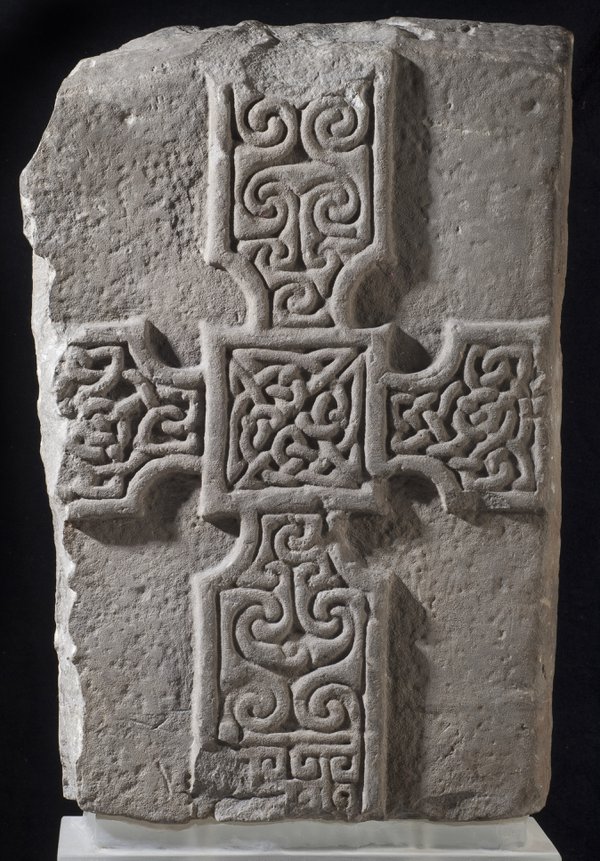
Cross Slab 'X.IB 27', 9th century. Image © National Museums Scotland
Cross slab
Monifieth, Angus, Scotland
800 - 900 AD
Material: sandstone
On loan courtesy of National Museums Scotland, this carved Cross slab includes both Christian and Pictish imagery. The Picts were a group of people who lived in northern and eastern Scotland. By the end of the 7th century, most Pictish people had converted to Christianity.
The Picts had ties to both Northumberland and Iona, and were influenced by the artistic style of these regions. One side of this carving shows a cross decorated with interlace and knotwork. On the other, Pictish bird-headed figures sit above beasts, a monster and a crescent. This fusion of imagery is an example of how Christian converts sometimes held on to their past traditions.
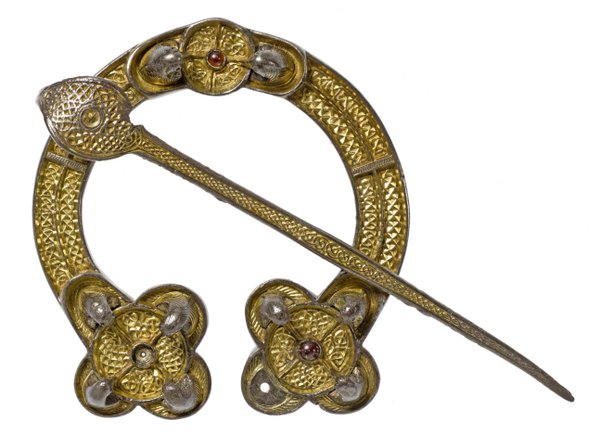
Rogart Brooch 'X.FC 2’, 8th century. Image © National Museums Scotland
Gold-plated silver brooch
Rogart, Sutherland
8th century
Gold, silver, glass
Brooches were worn by both men and women as cloak fasteners. The size and the quality of their decoration signified the wearer’s position in society.
This brooch is decorated with interlace patterns and bird ornamentation. In Christian art, birds drinking from a fountain symbolised eternal life. Even though the brooch is not a religious object, it contains symbolic meaning and would have been an expression of the wearer’s Christian faith. On loan courtesy of National Museums Scotland.
The Trumpington Cross and Linked pins
Cambridgeshire
7th century
Gold and garnet
This gold and garnet cross was found on the skeleton of a 14–18-year-old girl. It dates from 650-680 AD, making her one of England's earliest converts to Christianity.
Though her identity is a mystery, the girl was undoubtedly of aristocratic or even royal status. She was laid to rest in an extremely rare ‘bed burial’ ceremony. The bed consisted of a wooden frame held together by metal brackets, with a straw mattress. The body was then placed on the bed, probably when it was already in the grave.
Treasured possessions including gold and garnet pins, an iron knife, glass beads and a chain were also found in the grave.
Read more about The Trumpington Cross.
On loan from the Museum of Archaeology and Anthropology, University of Cambridge
Ireland
8th century
Ff21v-22r
As their name suggests, Irish ‘pocket’ Gospels are characterised by their small size. Being portable, they were well suited to private reading and prayer, but may also have been used for preaching.
As their name suggests, Irish ‘pocket’ Gospels are characterised by their small size. Being portable, they were well suited to private reading and prayer, but may also have been used for preaching.
These ‘pocket’ books contain fewer illustrations than larger versions. Their decoration was usually limited to portraits of the four authors of the Gospels - Matthew, Mark, Luke and John. This page opening shows a full-length portrait of St. Luke, framed by interlaced animals and holding a copy of his Gospel.
On loan from The British Library
Art and Spirituality
In the third space, visitors will see how art and spirituality have developed in the centuries since the Lindisfarne Gospels were created. A number of paintings, drawings and photographs have been loaned for the exhibition, reflecting how artists throughout history have represented the spiritual state of their time.
They will include Old Master religious works, the Romantic painters who sought spiritual experience through nature, and contemporary artists exploring the deeper questions of life. Combining works from across different faiths, as well as outside of formal religion, the exhibition will explore themes of spirituality, connection and identity in a way that is relevant to today’s world.
Highlights from this gallery:
Nothing will stay the same
2019
Mariele Neudecker
Glass, water, salt, resin
Lent by the artist
In this Space we Breathe series
2017
Khadija Saye
Silkscreen prints
Inhale IV and Exhale IV
2020
Zarah Hussain
Acrylic on gessoed plywood panel
The Deliverers by Jeremy Deller
Turner Prize winning artist Jeremy Deller will produce a new film exploring the Lindisfarne Gospels through space and time.
The Deliverers is free to view, and located in our White Cube Gallery, on the first floor.
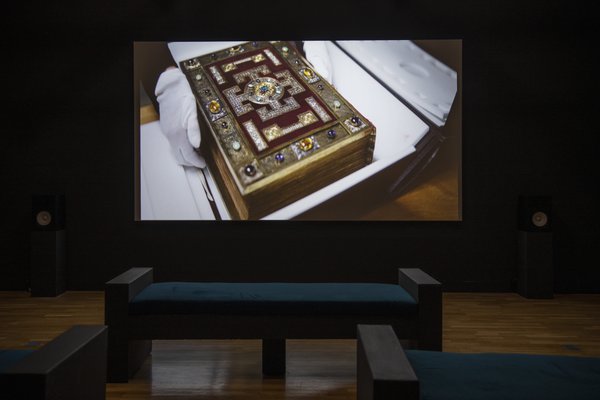
Photography by Colin Davison.
These are Our Treasures
This display features precious objects belonging to people of the North East.
Developed by artist Ruth Ewan, These are Our Treasures is a project created in response to the Lindisfarne Gospels, and will be on display from 30 July 2022 - 11 February 2023.
The objects and their related stories were gathered when Ruth Ewan asked the question, ‘What do you treasure?’ through a series of workshops in libraries across the region, as well as a public open call throughout the spring.
Artist Ruth Ewan introduces us to These are Our Treasures, in this short film below:

Over two hundred submissions were received and Ruth selected the pieces for this final display which offers a diverse cross section.
One of the objects on display is a bar of soap, with a French maker’s name, on loan from Jean in North Shields: “This soap was used for my father’s first bath in 1904...it was wrapped up carefully and forgotten about. My grandfather was a hairdresser/wigmaker on North Shields Fish Quay so he probably had access to ‘foreign’ imports. Sadly, I never met him.”
Katie, from Boldon in South Tyneside, lent a medical feeding tube and peg: “I treasure the memory of my baby brother arriving. My family fostered and now cares for him long term. He is four and is fed through a tube. When he arrived, I learned how to care for him. The object is important to me as it represents a time in my life where I was given a role to care for someone who I was not related to. This experience has altered my journey in life, both in a positive and negative way, but ultimately it has changed my outlook on most things. I have become more empathetic and understanding and I treasure that person who I have become because of this 'object', memory, situation. Advocating for someone else’s needs.”
Austin (age 8), from Whitley Bay, lent his fossil collection: “My fossil collection is made up of finds from Whitley Bay beach and one special fossil given to me by my granny. I find fossils fascinating! They're so old and the process of discovering them is very exciting. I love going down to the beach with my fossil hammer and smashing stones open to see what might be inside. I wear safety glasses during this process to protect my eyes. There are lots of fossils on Whitley Bay beach... If a rock has white spots or stripes in its surface, it is a good sign a fossil might be inside!”
Alan, from Horsley, submitted a red silk handkerchief: “The handkerchief was made by my mother as a gift for the pocket of her then boyfriend, and much later my father, Harry Holmes. At the time she was working for an elite dressmaker in Newcastle. She asked permission to use a remnant of the offcuts of the bale. That remnant had the identifying legend in gold paint stating, in code, the origin of the bale, the length, the quality etc. Minnie Van De Velde agreed to let her have the legend but that she could only make the handkerchief in her own time and that she should pay for the thread and binding she used. It reminds me of my heritage, of the responsibilities my mother took on when her own mother died in the early 1900s when the family left Scotland to move to Newcastle. This small red handkerchief evokes much of my own family history and of the social history of the times."
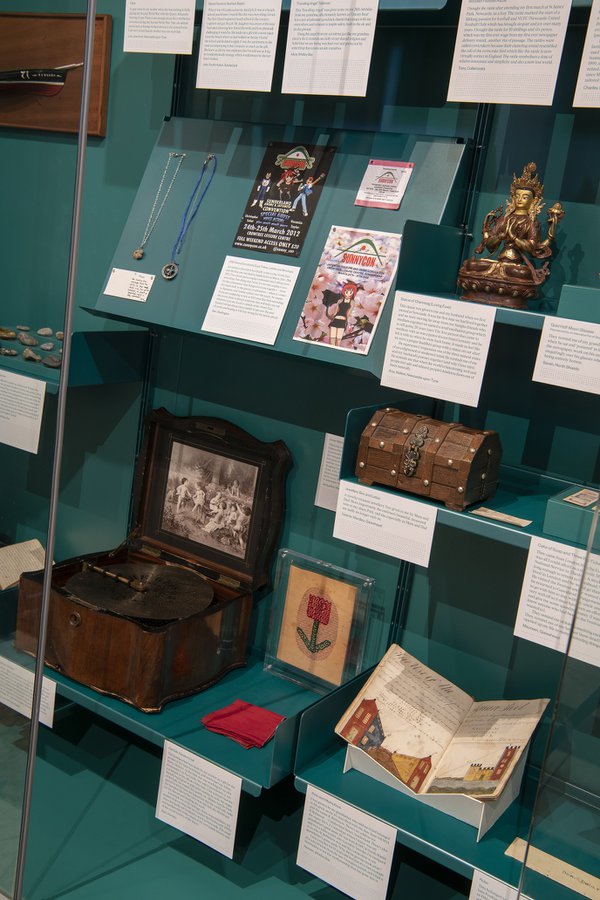
At times funny, at times poignant, and always deeply moving, the objects and their associated stories form an unconventional museum display revealing local hidden histories.
Although seemingly different, these treasures have much in common. Objects that are passed on, shared, made or found are treasured over what is bought. They reflect our cultural heritage and working lives and, perhaps most powerfully, speak of our treasured relationships with one another. Some are not an object at all, they represent an intangible treasure such as a feeling, a way of being or a memory.
Photography by Colin Davison
The Untold Stories and the Tides of Change to Come
The Untold Stories and the Tides of Change to Come is a new display co-curated by L-INK.
L-INK are a group of young people aged 16-23 years old who work with the Laing Art Gallery to organise events, work with artists and create artworks.
In the past, L-INK have worked on facilitated projects with gallery staff, and have had the opportunity to meet artists, curators and different gallery teams; they have created artworks and events and made and delivered creative interpretations of works from Hatton Art Gallery and Laing Art Gallery collections.
This year, we have worked with the young peoples' group to curate a display of Laing collections using the Gospels as inspiration, offering a new perspective upon the messages from Lindisfarne Gospels that are relevant to us today. L-ink worked with gallery staff and artist Ruth Ewan to research and answer big questions such as: why do we consider some objects ‘sacred’? How do our personal sacred objects contribute to our sense of self or self-worth? How does it feel to display a sacred object? Are there different ways to display artworks so that they tell different stories? What is the role of an artist or a curator?
The final selection of artworks on display have been chosen to represent the stages of life, belief, and realisation. In this display people will have the opportunity to see works from the Laing collection which haven't been on display for a number of years.
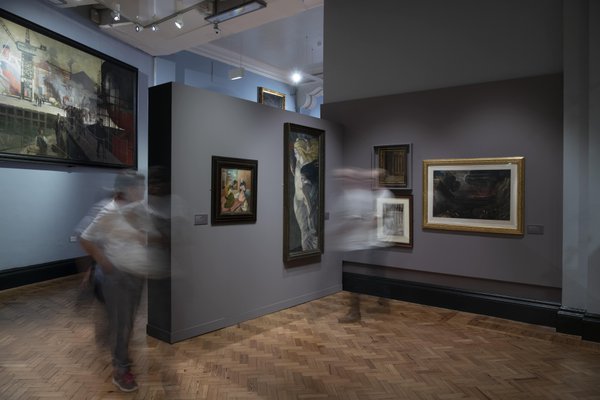
Photography by Colin Davison


